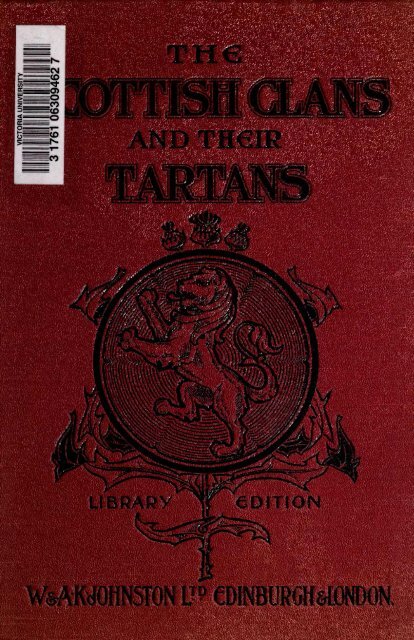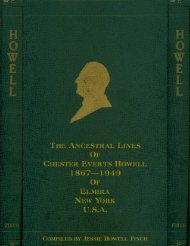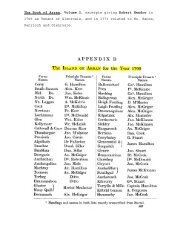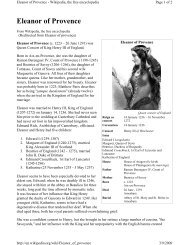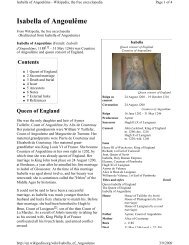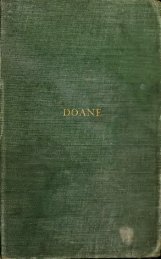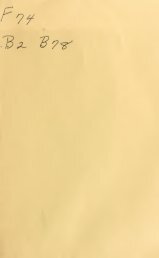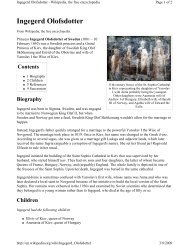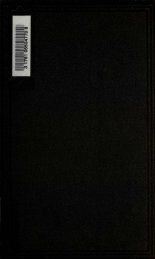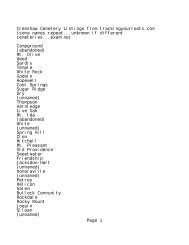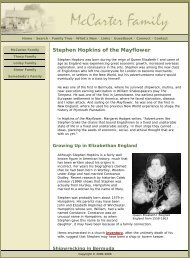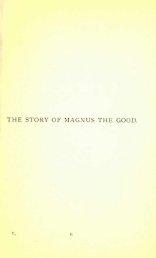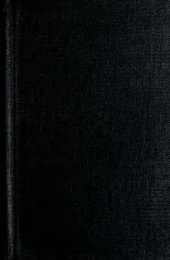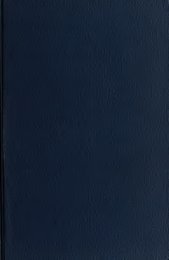Stewart Tartans - Adkins-Horton Genealogy
Stewart Tartans - Adkins-Horton Genealogy
Stewart Tartans - Adkins-Horton Genealogy
Create successful ePaper yourself
Turn your PDF publications into a flip-book with our unique Google optimized e-Paper software.
ico<br />
I<br />
AND THffi<br />
LIBRARY eOlTION<br />
P CDINBURCH^ffiNDON
THE SCOTTISH CLANS<br />
AND<br />
THEIR TARTANS<br />
WITH NOTES<br />
'Nowhere beats the heart so kindly<br />
As beneath the tartan plaid." AYTOUN.<br />
LIBRARY EDITION<br />
W. & A. K. JOHNSTON, LIMITED<br />
EDINBURGH AND LONDON
90<br />
OLD STEWART.<br />
War Cry: "Creag-an-Sgairbh" ("The Cormorant's Rock" on which is built<br />
Castle Stalker).<br />
Clan Pipe Music: Gathering "Bratach bhan nan Stiurbhartach " ("The <strong>Stewart</strong>'s<br />
White Banner"). March "Thainig mo righ air tir am Muideart"<br />
("My King has landed at Moidart").<br />
Badge : Darag (Oak); also the Thistle (Cluaran), the present national badge.<br />
That of the Pictish kings was Rudh (rue), which is joined with<br />
the Thistle in -the Collar of the Order.<br />
HIS tartan has been known for more than a hundred years as the " <strong>Stewart</strong>." Tartan,<br />
and is supposed to have been worn in former times by such families as the <strong>Stewart</strong>s<br />
of Appin, Giandtully, etc.
90. OLD STEWART.
91<br />
THE ROYAL STEWART5<br />
Badge: Darag (Oak).<br />
HERE are four ways of spelling this surname <strong>Stewart</strong>, Slteuart, Stuart, and Steward<br />
l<br />
besides the Gaelio version of it Stiubhard. The ancient form and original name,<br />
as spelt by the Royal Family, is <strong>Stewart</strong>, taken from the office of Lord High Steward<br />
of Scotland, which they held for nearly two centuries before they came to the throne.<br />
The first traceable progenitor of this gallant and royal race was a Norman, Alan,<br />
Lord of Oswestry, in Shropshire, whose family, almost immediately after their settlement<br />
in Scotland, became completely identified with the nationality of their new<br />
country, and were associated with all ita brightest achievements and deepest calamities.<br />
Walter, the sou of Alan, obtained from David I., in the twelfth century, a charter<br />
of the burgh and lands of Renfrew ; and Malcolm IV., by charter, made the office of<br />
High Steward hereditary in the family.<br />
In 1263, Alexander, the Lord High Steward, together with the King, led the<br />
Scottish army at the battle of Largs, when the Norwegians, under King Hacho, were totally defeated.<br />
King Alexander III. was wounded in the face by an arrow, and the Great Steward, fighting in the<br />
van, was slain. In 1286, his son, James the Steward, was appointed one of the Regency on the death<br />
of the young Queen Margaret ; during the Treaty of Paris in 1303, he was one of the commissioners<br />
sent to watch orer Scottish interests.<br />
Walter, the High Steward, when in the flower of his youth, with Douglas, led the left wing of<br />
the Scottish army at Bannockburn, and was knighted on the field by King Robert. In 1315, he<br />
married Marjory, the only daughter of the latter monarch. From this union sprang that race of<br />
sovereigns under whom the two kingdoms were eventually united, and whose descendant at this<br />
moment wears the British crown. Walter, the High Steward, died at Bathgate in 1328.<br />
On the death of David II., the High Steward ascended the throne as Robert II., and first of the<br />
House of <strong>Stewart</strong>.<br />
So numerous were the descendants and nobles of the House of <strong>Stewart</strong>, that we can but refer to<br />
them briefly. One of the most famous of these was John <strong>Stewart</strong> of Coul, afterwards Earl of<br />
Buchan and Constable of France. He was the youngest son of Robert, Duke of Albany, and of<br />
his second wife, Mnriela Keith, of the House of Marischal, and was born about 1380. His father,<br />
brother of Robert III., on the death of that unfortunate monarch, became Regent of Scotland ; and<br />
J-v his intrigues James I., the good and gentle poet-king, was detained till manhood in the Castle of<br />
Windsor.<br />
Ou the 16th of August 1424, the Earl of Buchan led a combined army of French, Scotch, and<br />
Italians at Vernenil, but was defeated and slain by the troops of Henry V., who buried him with<br />
every honour in the church of St. Gration at Tours. His elder brother Murdoch, who succeeded, in<br />
1420, to the Dukedom of Albany and Regency of the kingdom, was condemned and executed for<br />
malpractices by James I. After Mary bestowed the title of Albany on her husband, Henry, Lord<br />
Darnley and Mar, it became finally vested in the crown.<br />
The <strong>Stewart</strong>s, Lords Invermeath and Earls of Athole (from whom sprang the houses of Bonkil,<br />
Dreghorn, Dalswinton, Buchan, Traquair, etc.), were descended from Alexander, the Lord High<br />
Steward, who died in 1283, and was great-grandfather of Robert IF.<br />
On the death of the Constable of France at Vemeuil, without heirs, his earldom of Buchan was<br />
conferred on Sir James <strong>Stewart</strong>, second son of the Black Knight of Lorn, and his line ended with<br />
the death of Christian <strong>Stewart</strong>, daughter of John, Master of Buchan, who was killed at the battle<br />
of Pinkie in 1547.<br />
The family of Bute are descended from Sir John <strong>Stewart</strong>, who obtained from his father, Robert<br />
II., a grant of the Island of Bute, the ancient patrimony of the <strong>Stewart</strong>s.<br />
The Earls of Galloway are descended from Sir John <strong>Stewart</strong>, second son of Alexander, sixth<br />
Lord High Steward, who received from his father a gift of the lands of Garlics and was killed at<br />
the battle of Falkirk, 22nd July 1298.<br />
The first of the <strong>Stewart</strong>s, Earls of Angus, was Sir John of Bonkil, who was created Earl by<br />
David II. on his coronation in 1330. Three years after, he was killed at the Battle of Halidon Hill ;<br />
on the death of Thomas, third Earl of Angus in 1377, his titles and honours devolved on his nephew,<br />
George, who became the first Earl of Angus of the name of Douglas.<br />
Thie <strong>Stewart</strong>s, Dukes of Lennox, descended from Sir John of Bonkil, killed at Falkirk. Few<br />
families were more distinguished in war and peace than this line, from which were descended the<br />
families of Halrig, Barscob, and John, Lord d'Aubigny, famous in the Neapolitan wars under Charles<br />
VIII. and Louis XII. of France. The male line of this family ended with the death of Charles, Duke<br />
"<br />
of Lennox, of fever, at Elsinere, in 1672, when on an embassy to Denmark.<br />
The male line of the Royal <strong>Stewart</strong>s (or Stuarts) terminated with Cardinal York in 1807. He<br />
was the second son of James VIII. or "the Old Chevalier," and was born at Rome in 1725, and was<br />
baptised Henry. In 1745 he was at the head of 15,000 French troops assembled at Dunkirk to assist<br />
his brother. Prince Charles, when the fatal news of Culloden came, after which he exchanged tha<br />
word for the cowl. With him expired all the descendants of James VII.
91. STEWART, ROYAL.
92<br />
HUNTING STEWART.<br />
Badge: Cluaran (Thistle).<br />
ALTHOUGH we have failed to trace the history of this tartan, or fix the date of ita<br />
intrpdxiction, as it has long been a favourite with the people of Scotland, we thought<br />
it right to preserve in this work a record of one of the most beautiful tartans<br />
associated with the Royal <strong>Stewart</strong>s.
92. STEWART HUNTING
THE DRESS STEWART.<br />
Badge: Darag (Oak).<br />
HE old dress tartan of the Royal <strong>Stewart</strong>s is also known at the I present day as the<br />
"<br />
Victoria Tartan," Her late Majesty representing the <strong>Stewart</strong> family through James<br />
VI. of Scotland and I. of England, from whom she was descended. James I. left, with<br />
other children, a daughter, Elizabeth, who married Frederick V., Duke of Bavaria,<br />
Elector Palatine of the Rhine.<br />
His youngest daughter, Sophia, married in 1658 Ernest Augustus, Duke of Brunswick-<br />
Luneburg, Elector of Hanover. The son of the Elector, George Lewis, became<br />
King of Great Britain and Ireland as George I., and died in 1727, leaving<br />
behind him a son, afterwards George II. He was succeeded by his grandson, George<br />
III., who left thirteen children, two of whom succeeded to the throne under the<br />
titles of George IV. and William IV. The fourth son of George III., Edward, Duke<br />
of Kent, married in 1818 Victoria Maria Louisa, daughter of His Serene Highness,<br />
Francis, Duke of Saxe-Coburg-Saalfield. His daughter, Alexandrina Victoria, on the death of her<br />
uncle, William IV., ascended the throne on the 20th June 1S37, as Queen Victoria. Her Majesty<br />
died 22nd January 1901, and was succeeded by her eldest son, King Edward VII.
93. STEWART, DRESS.
94<br />
PRINCE CHARLES EDWARD STUART<br />
TARTAN.<br />
Badge :- Darag (Oak).<br />
[HIS tartan, which is associated with the memory of that unfortunate Prince, whose<br />
name is still a household word in Scotland, is nowise different from the <strong>Stewart</strong> (or<br />
Stuart), excepting that the broad red stripe in the latter is very much contracted.<br />
His achievements and adventures in the ever-memorable campaign of 1745-46 are<br />
too well known -to be referred to here, but his last days and funeral may be less so.<br />
"To the last his heart was with Scotland," and with those who suffered and<br />
perished in that lost cause, which has filled the land with song and melody.<br />
On the 30th of January 1788 he died in the arms of the Master of Nairn. His<br />
funeral obsequies were celebrated on the 3rd of February 1789, in the cathedral of<br />
Frescati, of which See his brother, the Cardinal Duke of York, was Bishop. The<br />
church was draped with black and gold lace and silver tissue, which, with the many<br />
wax lights, gave it a very solemn aspect. On the walls were many texts from<br />
Scripture emblazoned. A large catafalque was erected on steps in the nave of the edifice, on which<br />
lay the Prince's coffin, covered by a superb pall, whereon lay the Garter, George, and St. Andrew,<br />
which are now in the Castle of Edinburgh. It was embroidered with the arms of Britain. On each<br />
side stood gentlemen servants of the deceased in mourning cloaks, with wax tapers, and within a<br />
square formed by the troops in Frescati.<br />
At 10 A.M. the old Cardinal came to the church in a sedan, and, seating himself at the altar,<br />
began in a broken voice to sing the office for the dead. "The first verse was scarcely finished, when<br />
it was ob-served tliat his voice faltered, and tears trickled down his furrowed cheeks, so that it was<br />
feared he would not have been able to proceed ; however, he soon recollected himself, and went<br />
through the function in a very affecting manner, in which manly firmness, fraternal affection, and<br />
religious solemnity were happily blended."<br />
So with that solemn scene ended many a century of stirring Scottish history.<br />
From thenceforward the reigning family were prayed for in the Scottish Episcopal Churches.<br />
The monument erected to him, his father, and brother, the work of Canova, in St. Peter's, and<br />
by desire of George IV., has been justly deemed the most graceful tribute ever paid by Royalty to<br />
misfortune. It is inscribed thus :<br />
JACOBO III.<br />
JACOBI. II. MAGN.E. BRIT. REGIS. FILIO.<br />
KAROLO. EDVARDO.<br />
ET. HENRICO. DBCANO. PATRVM. CARDJNALIVM.<br />
JACOBI. III. FILIIS.<br />
STIRPIS. STVARDIAK. POSTREMIS.<br />
AN so. MDCCCIX.
94. STEWART, PRINCE CHARLES EDWARD.


